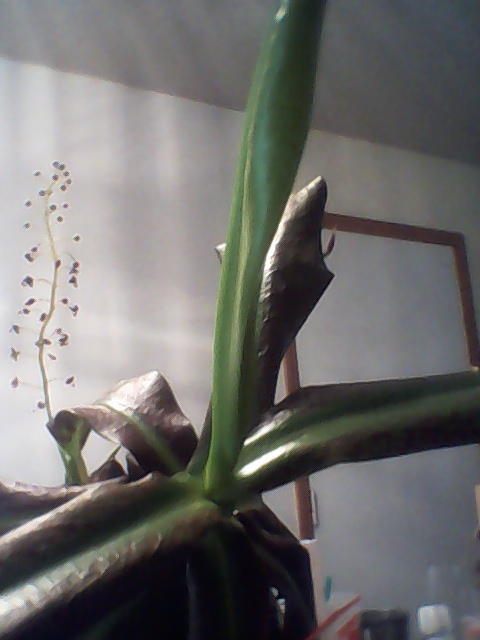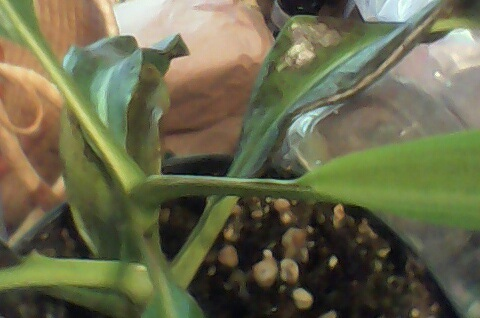Question sanguinea
sanguinea
 leaves
leaves
QUESTION: Hello,
I am having trouble with my nepenthes. It started out as a small brown spot and has spread to the underside and is now on the top side of the leaves. It started out with my sanguinea being the first and most heavily affected, then in just a day it spread to the rest of them, a few I'm not sure the variety, then my ventricosa, ventrata, and finally alata being the least affected. Some pitchers of affected leaves have dried up while others seem unaffected. They are all still growing, but the new leaves are also being affected.
For the last twoish weeks I have acclimated them to my home, they were outside on my porch, getting direct morning sun and dappled the rest of the day. They still get the direct morning sun, and a few hours less of dappled sun in the evening. They are hanging on the porch door or on the table next to the door. I water them with collected rain water every three days. They range in age from seedlings to flowing maturity. I also have a regular 60W household light that is on for a few hours each day. The humidity is probably around 50%, just a guess.I have had most of them since this spring, a couple I've only had a month or so, but they were all thriving on my porch. The temp in the house is usually 60-70 day and a little cooler at night. The other plants (butterwort, cactus, house plants) that are next to them are not affected. Should I cut the brown leaves off?
Three days ago, I sprayed them all with a generous application of neem oil, but it didn't seem to help. What do you think it is? Please help me save my plants, I really don't want to lose them. Thank you!
ANSWER: Based on your photos, your plants have signs of cold damage - brown patches along the edges of the leaves, the leaf rib is brown near the tip but green near the stem, leaf curling under itself, older leaves affected first. I don't see any signs of insect damage, or even possible malnutrition.
You said you had them outdoors until a couple weeks ago. Since you didn't mention your location, I can't determine how cold it had gotten for you. The plants you mentioned can typically handle night temperatures into the upper 40s for a night or two if properly acclimated. If there was a sudden cold spell that dropped the temperature too quickly or the cold nights lasted for more than a few days, this can cause the cold damage seen in your plants. This can happen in late summer and early fall when it's warm and a sudden unstable weather system moves in and brings in cold air. (This type of cold damage can also occur if Nepenthes are in the draft of an air conditioner.)
You also mentioned that you have it indoors on a porch door. Based on your description, I'm uncertain whether the plants are actually inside your house or simply in an enclosed, uninsulated porch. If the porch is uninsulated, you will need to bring your plants in the actual enclosure of your home where the night temperature doesn't get as cold.
You also mentioned using a 60-watt household light. I'm not sure what this is, whether it's an incandescent bulb or a compact fluorescent bulb. If it's incandescent, you will need to switch to a high wattage compact fluorescent bulb. Incandescent lights are woefully inadequate for plants of all types. Your plants are also showing signs of insufficient lighting. (Both cold temperatures and inadequate lighting will reduce your plants' energy production. If energy production gets too low, the plant will discard leaves that use too much energy.)
You also mentioned about other types of plants in your collection. Avoid judging the growing conditions for your Nepenthes using those plants. Those plants have different physiological requirements as Nepenthes.
For now, provide more lighting and warmth (nighttime) for your Nepenthes. Move your plants to a sunny south window that receives several hours of direct sunlight. This will correct some of the cultural issues and hopefully prevent additional complications. I also recommend watching our DVD, Volume 3. It shows you proper growing conditions for these plants. At the very least, read our care guide for Nepenthes on our main website.
http://www.growcarnivorousplants.com/careguides
As for the plants themselves, they will look a bit unsightly for the next six months until the days become long again. The current damage is permanent. You will need to wait for new growth and new basal shoots for the plant to look normal again. Unfortunately, as we head towards colder weather and shorter days, this will increase your plants' recovery time. You might lose the sanguinea since it seems to be most affected. Even after correcting the cultural issues, the plant may or may not have enough leaf area for optimal photosynthesis. It's energy production will still be hampered by the lack of sufficient healthy leaves. Only time will tell.
Keep us posted if you need further assistance.
Good growing!
Jacob Farin
---------- FOLLOW-UP ----------
QUESTION: Thank you for your help. I don't have any south windows, just east and west, which would be better? I live in Portland, or and the plants are inside my home. For lighting, do I need a special lamp or can I use a regular lamp with the florescent bulb? What is a good temperature range, and should it be the same all the time? Thank you again!!
AnswerSince you live in Portland, a west window would be better. As for the compact fluorescent bulb, since I don't know what type of light fixture you're using, you will need to check the instructions on the compact fluorescent bulb. Some of the higher wattage bulbs require a special fixture, and the instructions will state so on the package. The lighting hours should match what they would experience in the tropics - 12-14 hours.
As long as you grow your Nepenthes in your home, the temperature range should be OK. If you're comfortable, they're comfortable. If you feel cold without wearing a sweater, then they "feel" cold, too. In general, if your night temperature remains above 60, your plants will be fine.
Make sure to read the care guide for lighting and indoor growing instructions. You would also benefit from watching DVD Volume 3. We show you what is the optimal growing conditions for Nepenthes.







